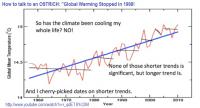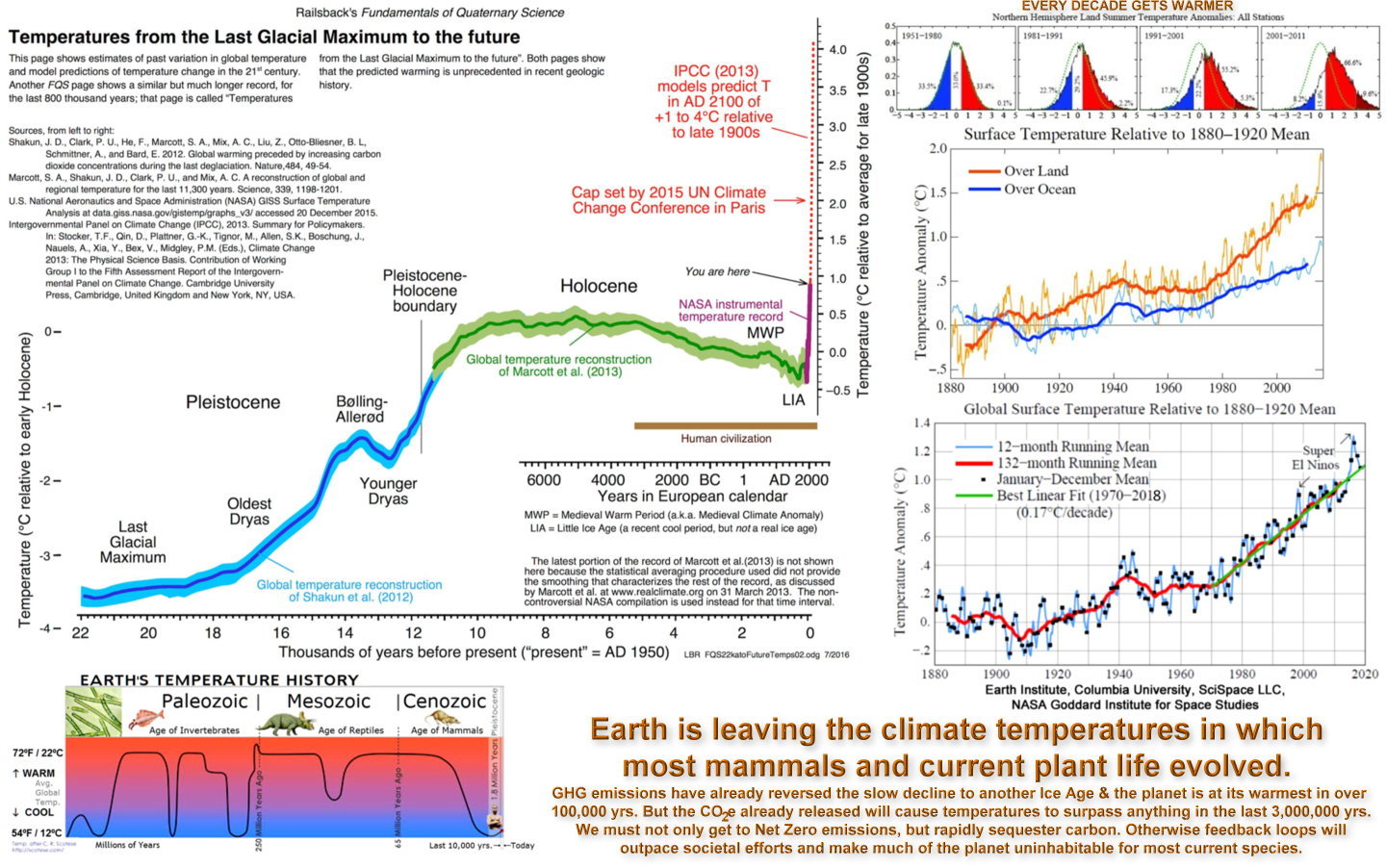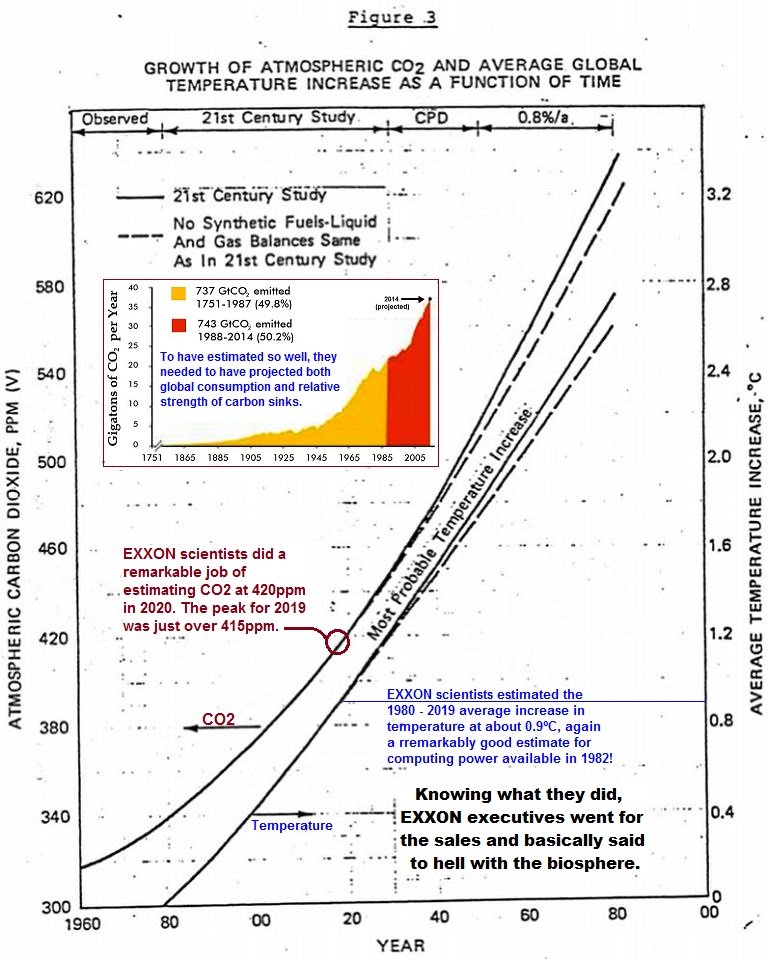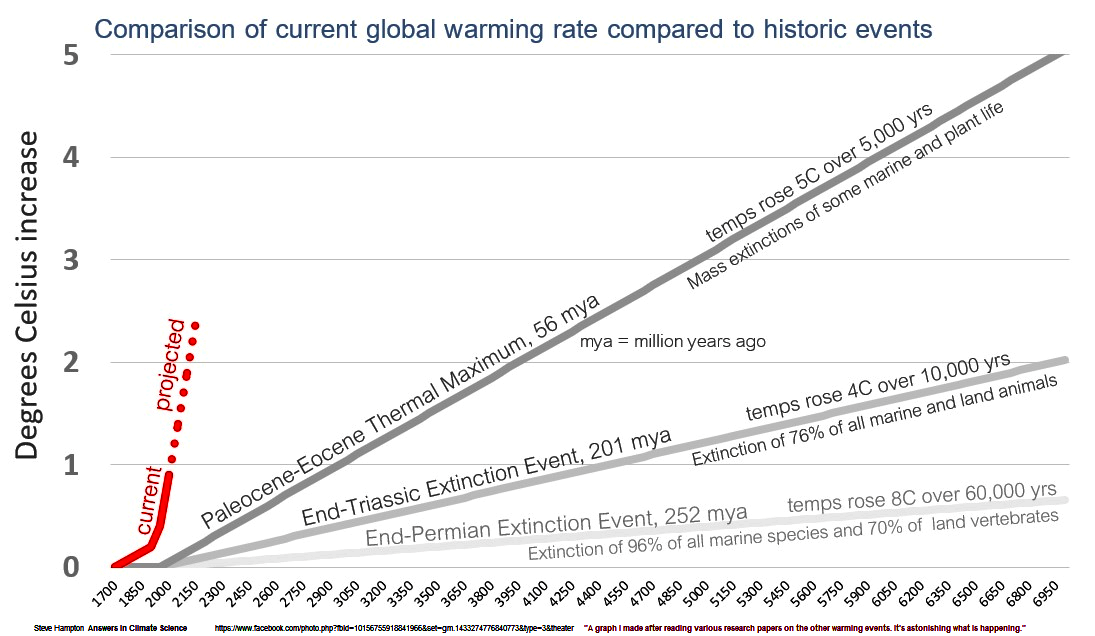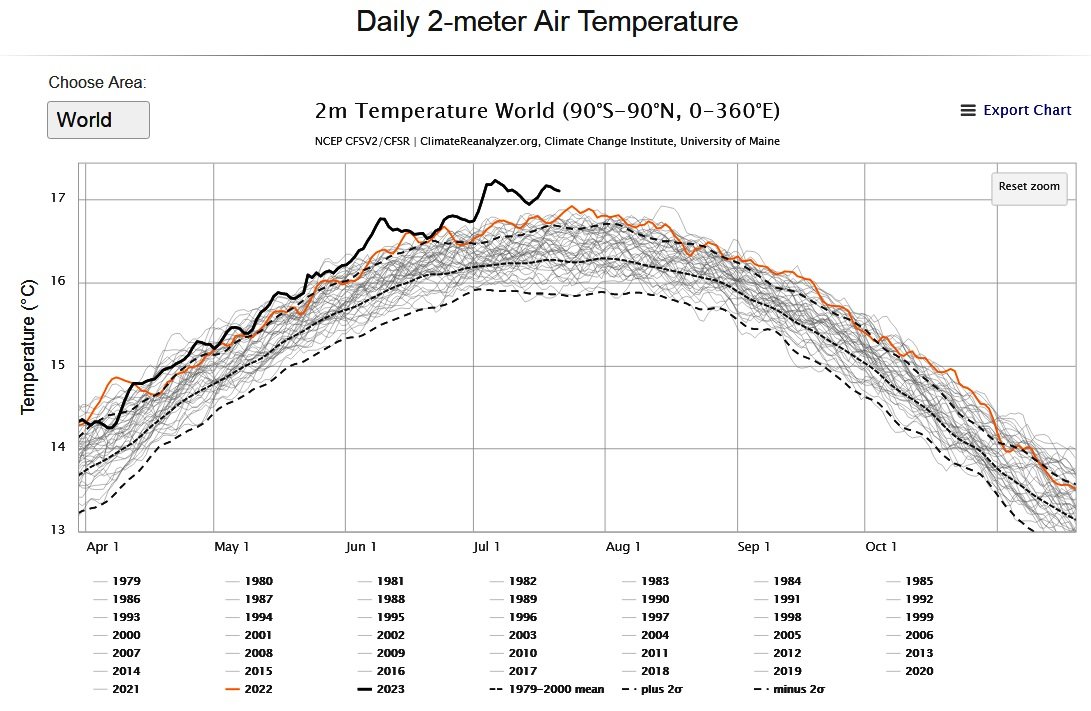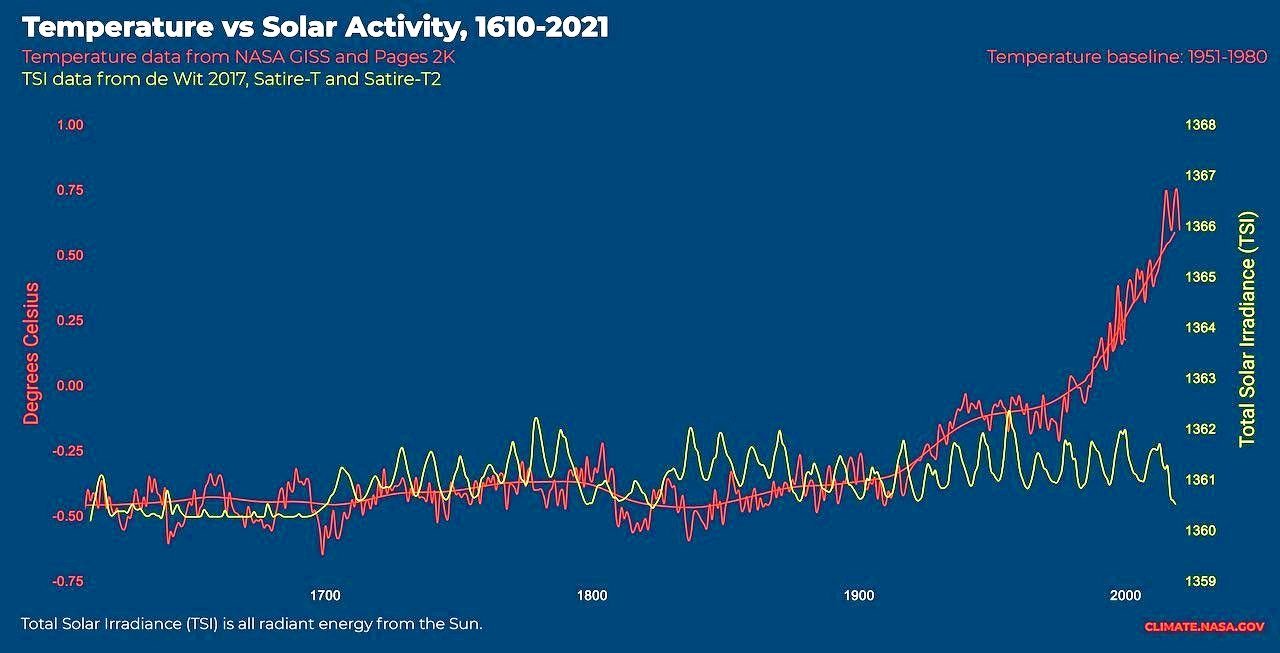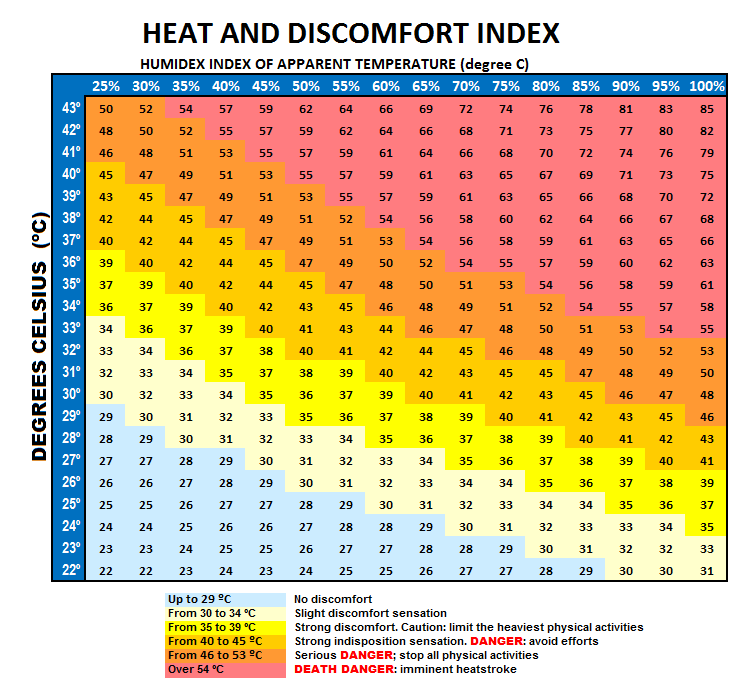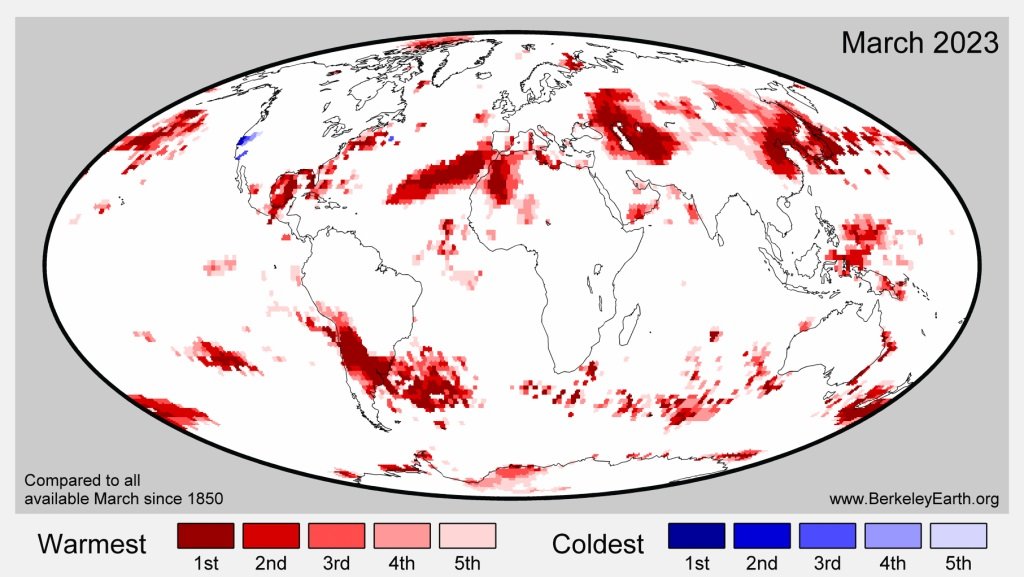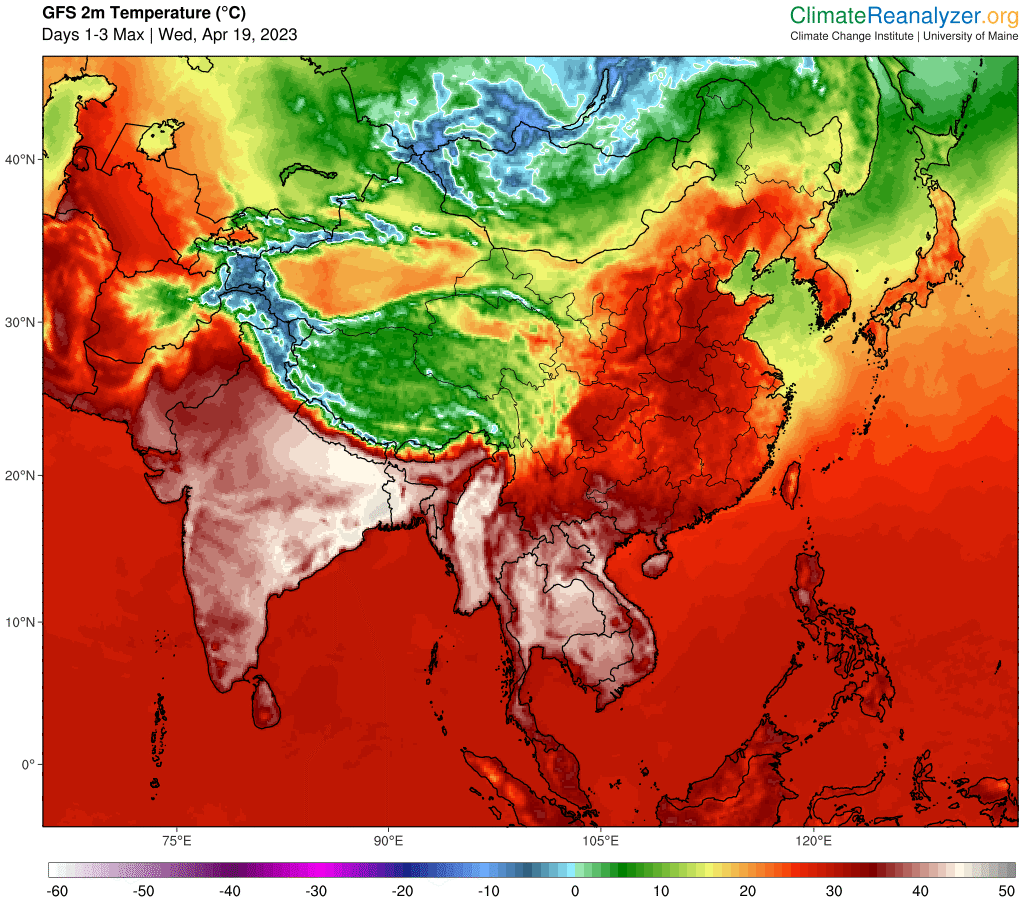-
Posts
630 -
Joined
-
Last visited
Content Type
Events
Forums
Downloads
Quizzes
Gallery
Blogs
Everything posted by RPCVguy
-
As was noted, Europe is just a portion of the planet. A shift in the Atlantic Meridional Overturning Circulation, or "AMOC," accounts for cooling temperatures in Europe. An exhaustive review of many sites through time shows our planet was warmer earlier in the Holocene, then began cooling towards another Ice Age... until the cumulative increase in greenhouse gases (predominately of CO2) halted, then reversed the cooling. We are now warmer than at any time in since the beginning of the last Ice Age. We are aiming to soon surpass temperatures since over 3 million years ago. The rapidity of change is not something trees, mammals , and the web of life upon which we depend can handle. The rapidity of change outpaces what killed of most species in past mass extinctions. This was answered with a graph accurately showing repeated 15 yr trends and the long term trend. Cherry picking the data does allow showing multiple periods of cooling (La Nina dominated cycles when the oceans soak in the heat into their depths.) BUT, the long term trend is warming... obvious to anyone who'll look. The natural cycles our planet was in for the last few million years was cooler than the norm for our planet. Weathering of rocks from past lava flows reduced the CO2 of the atmosphere as it weathered rocks into carbonates. BUT that natural cycle that allowed orbital cycles of our planet to go in and out of ice ages was halted and then reversed by the release of greenhouse gases that we humans did as we accessed and burned fossilized deposits of coal, oil and gas. (see the very long term temperature history in the bottom left portion of my first graphic.) The scientists at EXXON were tasked with researching the impact of the continued use of EXXON's main product back in the 70s, and delivered their answer in the 80's They did a remarkably good job of predicting the temperature increase we are already experiencing. This Carbon Tax idea has been reviewed and improved upon. James Hansen has been promoting a CARBON FEE & DIVIDEND plan since at least 2015. Here is his PDF on the subject as of 2019 https://csas.earth.columbia.edu/sites/default/files/content/Fee-and-Dividend-Miller-Hansen-20191110-1.pdf A search for the topic shows attempts to pass it into law in the USA, though the partisanship of politics has prevented rational application. Benefits of a Carbon Fee/Tax would be to disincentivize moving manufacturing to nations with dirtier production - automatically imposing tariffs. The benefits of the Dividend is to eliminate this as a governmental income stream. Pass the Fees back to the population on a per capita basis. Those who generate more CO2 would be incentivized to shift their habits. Those who generate less CO2 would receive cash (monthly?) to cover rising costs.
-
The planet has been warming rapidly over the past decades, sufficient to be warmer than at any time since the last ice age. Of those recent warm decades, the planet surpassed prior records on July 3rd and has remained in new record territory since then. July 7th is the current record, while July 14th still beat the 2 dates tied for the prior record. the image is a subset of the info at: • https://climatereanalyzer.org/clim/t2_daily/
-
Orbital and precession shifts are slow, ... and would currently be cooling the planet. Solar cycles matter, but are not currently dominant is shifting the Earth's temperature balance. What has most affected the planetary energy imbalance, causing a net warming, is greenhouse gas accumulation in the atmosphere. These gases (CO2, CH4 and NO2) are adding to the insulation of the atmosphere. This graph definitely rebuts the notion that solar cycles are dominant at this time. What showed up as an abnormality and accumulated after 1900? ... especially in the 2nd half of the 20th Century? CO2 from the combustion of previously sequestered dead plants. Bloomberg posted an excellent animation that initially was easy to view... it compared all the major factors acting individually, then all but CO2, then all - including CO2. CO2 is definitely the dominant change to the Earth's energy imbalance. • http://www.bloomberg.com/graphics/2015-whats-warming-the-world/ This is the top link in this freely accessible page • https://earthobservatory.nasa.gov/blogs/earthmatters/2016/01/25/four-graphics-and-a-book-that-help-explain-climate-change/
-

Heat Index Rises to 54°C in Some Areas, Health Risk Warned
RPCVguy replied to webfact's topic in Thailand News
The Heat Index was developed to better represent the potential threat to life that the weather can pose. Heat Index combines heat and relative humidity into a number that conveys how easy or hard it will be to shed the heat our bodies generate by our metabolisms. If we can't shed the hear, then heat stroke becomes a possibility. How quickly can it kill? that depends upon health and conditioning to heat of the individual, but 6 hours in such conditions will kill even young people of excellent health. There is a related "Misery" Index that also factors in wind speed for the ability of moving air to assist in chilling the body. It is far harder to compute, but in broad terms are regularly mapped from data collected by satellite. Most places in Thailand only get into the amber color zone for an hour or 2 per day. It is worse in India near Pakistan, just before the monsoons fully take over the season there, Here is regional map from April 19th. https://earth.nullschool.net/#2023/04/19/0700Z/wind/surface/level/overlay=misery_index/orthographic=-266.77,17.23,3854/loc=99.729,13.708 Here is a Heat Index table , with the relative humidity of the moment on the horizontal axis, temperature on the vertical, and the Heat Index as the intersection of the two. -
In my last comment I somewhat promised to provide the April update mapping. It was just published in the last 24 hours. Reading the color codes, the central and eastern regions ranged from the warmest to 3rd warmest months in recorded history. The north and south each missed being in the top 5 Aprils on record (records in Thailand go back to 1840, but not so many stations as now. Currently there are 119 stations with reporting included in the satellite supplemented data collection.
-
Besides talking about the weather, I like tracking it - as demonstrated in my earlier post. Besides those above links is one that issues comprehensive reports with monthly and YTD data. It is https://berkeleyearth.org/about/ The report for March came out in mid-April and I'm linking to one of its images. It shows average monthly data and color codes in shades of red or blue the locations that experienced temperatures in the recorded top 5 for heat or cold. The monthly report shows images for the average temperature range, but this image is good for highlighting extremes. It is just one of the many images mapped and graphed at https://berkeleyearth.org/march-2023-temperature-update/ ... Sometime in mid-May we'll get to see which parts of the world had record (or near record) heat in April. I'll vouch for this being a miserably uncomfortable month here in the far north of Thailand; I rarely use our air conditioner, but this past week I used it daily. What would be interesting would be people predicting what degree of red will appear in what locations in Thailand. I expect shades of red to appear over northern Thailand. Yet, as the meteorologist noted in his story, April is always hot in Thailand. We await sufficient rain and monsoons to cool things. Talking about the weather is a strong part of human culture. It affects our comfort, our ability to work, play, travel, ... or have a successful crop season. At its extremes it can threaten our lives. In the short term talk is cheap and we can't do much about it other than seek shelter and hope the power does not go out. Here is the El Nino forecast listed on that March update: "a 60% chance of a shift to El Niño conditions during the middle or end of 2023. Models currently disagree on the intensity of the possible El Niño, with some models predicting a very strong event, while others are more moderate. The developing warm pool in the Pacific will likely give us a clearer idea of what to expect within a few months." It closes that topic stating: "it is likely that any El Niño will have a greater impact on 2024 global temperatures than it does on 2023." Since the HOT season for Thailand is in April and May, Thailand won't truly see the El Nino extreme heat effects until April of next year. As for some of the commentary that I'm sure will follow. There is a swamp of misinformation and snide commenting posted on sites like this. Misinformation won't change what the weather will do, but it may cause good people to suffer consequences of being ill-prepared.
-
Yes, RECORD HIGH TEMPERATURES do not get hit each new day. Weather is affected by time of the year and a string of variables. The trend (the climate) though is unmistakable. The Earth is warming and the insulation level of greenhouse gases are now at levels not seen for the last 3 million years. That is why the current starting position for an El Nino is concerning. During the El Nino that Peaked in 2016, Earth warmed to a new plateau of temperatures. While 2014 was the warmest year experienced until then, it is the coolest of the years since then. It looks like 2023 is about to start us up to anew and higher plateau on the graphs of global temperature. As cited last time. ♦ Sea Surface temperatures are at a record high, have been so since early March, and are not yet dropping as past years have done. https://climatereanalyzer.org/clim/sst_daily/ ♦ All 3 persistent greenhouse gases are at record high concentrations, trapping more heat into Earth's system https://www.esrl.noaa.gov/gmd/ccgg/trends/monthly.html ♦ We are entering this summer with the 2nd lowest Arctic Sea Ice Volume on record. (We also know the waters beneath the ice are warmer than in past years. http://polarportal.dk/fileadmin/polarportal/sea/CICE_curve_thick_LA_EN_20230414.png You wanted accurate global temperature readings for hundreds of years. The MOST precise data goes back to 1880, as broken out in the graphs at the right as attached. The larger graph at the left lists the specific studies, color coded by the time frame. The level of uncertainty is designated by the lighter greens and blues above and below the primary line. The basis for the green line is a 2013 study. • https://www.science.org/doi/10.1126/science.1228026 It is discussed more accessibly at: • https://www.sciencedaily.com/releases/2013/03/130307145303.htm
-
Thanks for bringing in both a source of data AND a mention of the El Nino that is forming. Here is another site that lets people see the current forecast and compare it to historical averages. I like that it maps the data. The root site gives far more options. https://climatereanalyzer.org/wx/fcst_outlook/?dm_id=asia-lea2&ndays=d1-3 From that site, the maximum temperatures map choice across the region as captured on Wednesday is in this image. The whitish color indicates temperatures over 40ºC. People looking at the mapping of temperature anomaly will see that Thailand , and SE Asia in general is warmer than average. The global news did get kicked into attention when the April 14th temperatures broke a lot of records, notably in Tak, which was recorded to have hit 45.4ºC. The historical data for specific satellite readings on heat, humidity, misery index, pollution and more can be accessed at this site. https://earth.nullschool.net/#2023/04/18/0700Z/wind/surface/level/overlay=temp/orthographic=-265.36,17.23,1823/loc=99.429,16.842 El Nino is VERY worth mentioning because during El Nino the oceans release more of their heat to the atmosphere than during La Nina (when the heat gets stored into ocean depths.) As El Nino arrives FOUR different indicators are in a bad starting position. Here is how (with references) ♦ Sea Surface temperatures are at a record high, have been so since early March, and are not yet dropping as past years have done. https://climatereanalyzer.org/clim/sst_daily/ ♦ All 3 persistent greenhouse gases are at record high concentrations, trapping more heat into Earth's system https://www.esrl.noaa.gov/gmd/ccgg/trends/monthly.html ♦ We are entering this summer with the 2nd lowest Arctic Sea Ice Volume on record. (We also know the waters beneath the ice are warmer than in past years. http://polarportal.dk/fileadmin/polarportal/sea/CICE_curve_thick_LA_EN_20230414.png ♦ Solar radiance cycle is on its pattern of increase and will increase into 2026. https://www.swpc.noaa.gov/products/solar-cycle-progression
-
Add to the DUI duties at checkpoints. Our town's police went around and announced the e-bikes and e-trikes would be prohibited in town from today through Sunday (or Monday?) There goes my access to 7-Eleven or Tesco for the half mile that is our town's shopping district. Regular bicycles still allowed, but I stopped using mine as they had widened the highway and caused traffic to be faster even as they left less room to walk or bike safely. My trike is far more visible to drivers overtaking me on the road. As it is, too many very narrow misses to venture out, especially since I suspect many DUIs will get past the checkpoints as not being too tipsy in the moment.
-

Heatstroke: What is it, how does it occur, and how to prevent it?
RPCVguy replied to webfact's topic in Thailand News
A link that shows a related index (The Misery Index) is available at • https://earth.nullschool.net/#current/wind/surface/level/overlay=misery_index/orthographic=-265.14,13.53,2340 The data is from global satellite readings and maps perceived air temperature as combination of heat index and wind chill. Note that there is a control panel accessed by clicking on the word "earth" located at the bottom left of the image. -

Heatstroke: What is it, how does it occur, and how to prevent it?
RPCVguy replied to webfact's topic in Thailand News
Doctormann provides a very nice chart that I've not seen before. I like it for posting BOTH ºC & ºF in the headings. I've been using a different one that lists only ºC. It does have an advantage of showing Relative Humidity down to 25%, and giving advice as to how to behave in those conditions. Nigelforbes added a comment about relative humidity getting very high but it lacks context as to time of day or conditions during June through October. The relative humidity is calculated against the temperature at the moment. High relative humidity is most common just before and after dawn. As the temperature rises, the atmosphere is able to hold 7% more water vapor for each degree Celsius the air warms. The time when high temperature and humidity is most likely to occur is as the season changes from the hot dry season to the monsoon season. That is when rain, hitting roads, roofs, and other hot surfaces, quickly evaporates off and raises the humidity while still having a hot environment. A few hours of such conditions will kill even the fittest of military persons, the elderly are at risk at lower temperature-humidity conditions. The 2016 and 2019 El Nino cycles kept the rains from arriving in Thailand until June,and heat had built up in the soil, roads, buildings, etc. etc. Those years we came close to experiencing what has been an annual situation in NW India near its border with Pakistan. Thousands have died during those events. A super such event is described in the opening chapters of the novel "The Ministry for the Future" in which the death toll over a week reached millions due to power grid failure/ A/C failure as the heat dome held sway. I appreciate the post overall. It is a useful warning that people need to add to their awareness as the climate shifts. -

Coming Soon to the AN ChatGPT System - You will be amazed!
RPCVguy replied to webfact's topic in Thailand News
Great post for April 1st. LOL -

Sinema leaving Democratic Party, will register as independent
RPCVguy replied to Scott's topic in World News
The last two paragraphs of the article posted by The Hill are key to the situation, as is Sinema's pattern of obstruction when monied interests of her donors lie elsewhere. The best video clip calling out move as opposite what her state's 2022 election demonstrates as desirable. https://www.msnbc.com/alex-wagner-tonight/watch/the-real-reason-kyrsten-sinema-left-the-democratic-party-156909125666 Summary: She knows her obstruction has already cost her any chance of being re-elected as a Democrat. Her hope is to be strong enough as an incumbent to split the Arizona vote in 2024, even as the urbanization of her state strengthens the odds of a win for Democrats. -
I've never had a problem with the Thai postal system. It is the hand-off to international carriers to the USA that is a problem. Does anyone know? ... Can we get details on what carrier? I suspect the problem is at the US Customs end, but there is a lack of transparency, despite mail be sent "registered" and "priority mail."
-
The Democrats definitely outperformed expectations since the gerrymandering of new redistricting was expected to net a 20 seat boost to the Republicans. Several people have mentioned the trends. Below is a snapshot of the history showing how only GW Bush's first mid-term (aided by post 9/11 fervor) showed a bigger deviation from the typical mid-term drubbing of the president's party.


